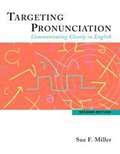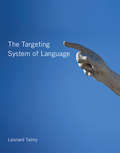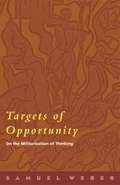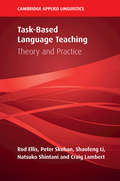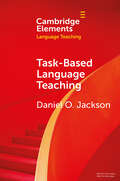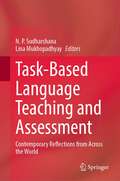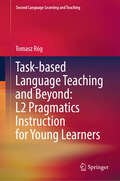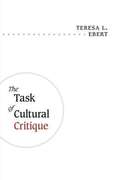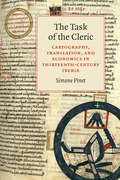- Table View
- List View
Target Spelling 1260
by Margaret M. Scarborough Mary F. Brigham Teresa A. MillerAn English Spelling book.
Target Spelling 180
by Margaret M. Scarborough Mary F. Brigham Teresa A. MillerAn easy to read English Spelling book.
Target Spelling 540
by Margaret M. Scarborough Mary F. Brigham Teresa A. MillerThis book is an English Spelling book.
Target Spelling 780
by Margaret M. Scarborough Mary F. Brigham Teresa A. MillerThis is an English Spelling book.
Targeting Pronunciation: Communicating Clearly in English (Second Edition)
by Sue F. MillerA comprehensive program for providing intermediate and advanced ESL students with the tools they need to communicate clearly in English. Using a communicative and interactive approach, the text provides extensive listening and practice with all aspects of pronunciation. This new edition, while updated, retains all the popular features of the original text. Targeting Pronunciation is organized around eight practical pronunciation goals, or targets. Most of these targets are suprasegmentals (stress, intonation, and speech rhythm). Segmentals (consonants and vowels) are also well covered, both in the text and in appendixes A and B. The targets presented early in the book are recycled throughout the chapters as students gain speaking experience and confidence.
The Targeting System of Language (The\mit Press Ser.)
by Leonard TalmyA proposal that a single linguistic/cognitive system, “targeting,” underlies two domains of reference, anaphora (speech-internal) and deixis (speech-external).In this book, Leonard Talmy proposes that a single linguistic/cognitive system, targeting, underlies two domains of linguistic reference, those termed anaphora (for a referent that is an element of the current discourse) and deixis (for a referent outside the discourse and in the spatiotemporal surroundings). Talmy argues that language engages the same cognitive system to single out referents whether they are speech-internal or speech-external.Talmy explains the targeting system in this way: as a speaker communicates with a hearer, her attention is on an object to which she wishes to refer; this is her target. To get the hearer's attention on it as well, she uses a trigger—a word such as this, that, here, there, or now. The trigger initiates a three-stage process in the hearer: he seeks cues of ten distinct categories; uses these cues to determine the target; and then maps the concept of the target gleaned from the cues back onto the trigger to integrate it into the speaker's sentence, achieving comprehension. The whole interaction, Talmy explains, rests on a coordination of the speaker's and hearer's cognitive processing. The process is the same whether the referent is anaphoric or deictic.Talmy presents and analyzes the ten categories of cues, and examines sequences in targeting, including the steps by which interaction leads to joint attention. A glossary defines the new terms in the argument.
Targets of Opportunity: On the Militarization of Thinking
by Samuel WeberThe title of this book echoes a phrase used by the Washington Post to describethe American attempt to kill Saddam Hussein at the start of the war againstIraq. Its theme is the notion of targeting (skopos) as the name of an intentionalstructure in which the subject tries to confirm its invulnerability by aiming todestroy a target. At the center of the first chapter is Odysseus’s killing of the suitors;the second concerns Carl Schmitt’s Roman Catholicism and Political Form; thethird and fourth treat Freud’s “Thoughts for the Times on War and Death” and“The Man Moses and Monotheistic Religion.” Weber then traces the emergenceof an alternative to targeting, first within military and strategic thinking itself(“Network Centered Warfare”), and then in Walter Benjamin’s readings of“Capitalism as Religion” and “Two Poems of Friedrich Hölderlin.”
Tarjetas de fotos [Grados 1–2] (¡Arriba la Lectura!)
by Houghton Mifflin Harcourt Publishing CompanyNIMAC-sourced textbook
Tarjetas de letras [ Grados 1-2] (¡Arriba la Lectura!)
by Houghton Mifflin Harcourt Publishing CompanyNIMAC-sourced textbook
Tarjetas de palabras [Grados 1 y 2] (¡Arriba la Lectura!)
by Houghton Mifflin Harcourt Publishing CompanyNIMAC-sourced textbook
Tarjetas de vocabulario [Grado 1] (¡Arriba la Lectura!)
by Houghton Mifflin Harcourt Publishing CompanyNIMAC-sourced textbook
Tarjetas de vocabulario [Grado 2] (¡Arriba la Lectura!)
by Houghton Mifflin Harcourt Publishing CompanyNIMAC-sourced textbook
Tarjetas de vocabulario [Grado 4] (¡Arriba la Lectura!)
by Houghton Mifflin Harcourt Publishing CompanyNIMAC-sourced textbook
Tarjetas de vocabulario [Grado 5] (¡Arriba la Lectura!)
by Houghton Mifflin Harcourt Publishing CompanyNIMAC-sourced textbook
Tarjetas del abecedario [Grado K] (¡Arriba la Lectura!)
by Houghton Mifflin Harcourt Publishing CompanyNIMAC-sourced textbook
Task-Based Language Teaching: Theory and Practice (Cambridge Applied Linguistics)
by Rod Ellis Peter Skehan Shaofeng Li Natsuko Shintani Craig LambertTask-based language teaching is an approach which differs from traditional approaches by emphasising the importance of engaging learners' natural abilities for acquiring language incidentally through the performance of tasks that draw learners' attention to form. Drawing on the multiple perspectives and expertise of five leading authorities in the field, this book provides a comprehensive and balanced account of task-based language teaching (TBLT). Split into five sections, the book provides an historical account of the development of TBLT and introduces the key issues facing the area. A number of different theoretical perspectives that have informed TBLT are presented, followed by a discussion on key pedagogic aspects - syllabus design, methodology of a task-based lesson, and task-based assessment. The final sections consider the research that has investigated the effectiveness of TBLT, addresses critiques and suggest directions for future research. Task-based language teaching is now mandated by many educational authorities throughout the world and this book serves as a core source of information for researchers, teachers and students.
Task-Based Language Teaching (Elements in Language Teaching)
by Daniel O. JacksonThis Element is a guide to task-based language teaching (TBLT), for language instructors, teacher educators, and other interested parties. The work first provides clear definitions and principles related to communication task design. It then explains how tasks can inform all stages of curriculum development. Diverse, localized cases demonstrate the scope of task-based approaches. Recent research illustrates the impact of task design (complexity, mode) and task implementation (preparation, interaction, repetition) on various second language outcomes. The Element also describes particular challenges and opportunities for teachers using tasks. The epilogue considers the potential of TBLT to transform classrooms, institutions, and society.
Task-Based Language Teaching and Assessment: Contemporary Reflections from Across the World
by N. P. Sudharshana Lina MukhopadhyayThis book provides interdisciplinary perspectives on task-based language teaching (TBLT) and task-based language assessment (TBLA) in English as a second language (ESL) context. It discusses theoretical and experimental insights of TBLT and TBLA from cognitive, cognitive linguistic, and psycholinguistic viewpoints. The chapters, written by leading language teaching specialists in the field, introduce the reader to a comprehensive range of issues related to TBLT and TBLA such as curriculum design, materials development, and classroom teaching & testing. With interdisciplinary appeal, the book is a valuable resource for researchers in task-based language teaching and assessment. It is equally useful for teachers to whom it offers practical suggestions for designing tasks for teaching and testing.
Task-based Language Teaching and Beyond: L2 Pragmatics Instruction for Young Learners (Second Language Learning and Teaching)
by Tomasz RógThis book provides a groundbreaking exploration of how task-based language teaching (TBLT) can effectively develop second language (L2) pragmatic competence in young learners. Bridging the gap between TBLT and L2 pragmatics, this volume addresses critical issues in language education, offering insights into teaching key speech acts. Specifically, it compares the outcomes of TBLT with the traditional PPP framework in teaching L2 speech acts to Polish learners of L2 English aged 8 to 9. Chapter 1 deals with pragmatics and pragmatic competence, highlighting its importance in effective communication and language use in social contexts. It addresses L2 pragmatics, the development of L2 pragmatic competence, and the challenges in teaching and assessing this competence. Chapter 2 overviews TBLT, its theoretical foundations, practical implementation, and related empirical research. It discusses the cognitive-interactionist and sociocultural perspectives on L2 acquisition and the effectiveness of tasks. Chapter 3 reviews empirical research on using tasks in teaching L2 pragmatics, especially to young learners. Chapter 4 details the research methodology used in the study, including the context, participants, target speech acts, data elicitation instruments, and analysis procedures. Chapter 5 presents the results of the study. Chapter 6 discusses the findings, their pedagogical implications, and the limitations of the study. Chapter 7 offers conclusions. Rich with pedagogical implications, the volume is an essential resource for researchers and practitioners interested in task-based and task-supported teaching, L2 pragmatics, and innovative approaches to teaching young learners.
The Task of Cultural Critique
by Teresa L. Ebert"A stimulating, path-breaking text that stands out as both an anti-text in the arena of cultural studies and as a classic Marxist analysis of the field of cultural critique." --Peter McLaren, author of Che Guevara, Paulo Freire, and the Pedagogy of Revolution "This powerful book confirms that Teresa L. Ebert is one of the most significant Marxist theorists currently writing about the humanities." --Barbara Foley, author of Spectres of 1919: Class and Nation in the Making of the New Negro In this study, Teresa L. Ebert makes a spirited, pioneering case for a new cultural critique committed to the struggles for human freedom and global equality. Demonstrating the implosion of the linguistic turn that isolates culture from historical processes, The Task of Cultural Critique maps the contours of an emerging materialist critique that contributes toward a critical social and cultural consciousness. Through groundbreaking analyses of cultural texts, Ebert questions the contemporary Derridan dogma that asserts "the future belongs to ghosts." Events-to-come are not spectral, she contends, but the material outcome of global class struggles. Not "hauntology" but history produces cultural practices and their conflitive representations--from sexuality, war, and consumption to democracy, torture, globalization, and absolute otherness. With close readings of texts from Proust and Balzac to "Chick Lit," from Lukács, de Man, Deleuze, and Marx to Derrida, Žižek, Butler, Kollontai, and Agamben, the book opens up new directions for cultural critique today.
The Task of the Cleric: Cartography, Translation, and Economics in Thirteenth-Century Iberia
by Simone PinetComposed in early thirteenth-century Iberia, the Libro de Alexandre was Spain's first vernacular version of the Romance of Alexander and the first poem in the corpus now known as the mester de clerecía. These learned works, written by clergy and connected with both school and court, were also tools for the articulation of sovereignty in an era of prolonged military and political expansion.In The Task of the Cleric, Simone Pinet considers the composition of the Libro de Alexandre in the context of cartography, political economy, and translation. Her discussion sheds light on how clerics perceived themselves and on the connections between literature and these other activities. Drawing on an extensive collection of early cartographic materials, much of it rarely considered in conjunction with the romance, Pinet offers an original and insightful view of the mester de clerecía and the changing role of knowledge and the clergy in thirteenth-century Iberia.

